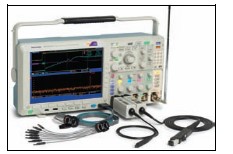
Tektronix, Inc., the world's leading manufacturer of
oscilloscopes, recently introduced the world's first
mixed domain oscilloscope (MDO) that delivers the
functionality of an oscilloscope and a spectrum analyzer in a
single instrument. The new MDO4000 Mixed Domain
Oscilloscope Series gives engineers the
unique ability to capture time-correlated
analog, digital and RF signals for a
complete system view, helping them to
rapidly solve complicated design issues.
More than 60 percent of oscilloscope
users also use a spectrum analyzer to
troubleshoot embedded system designs
with integrated wireless functionality,
requiring them to work in both the time
and frequency domain. Traditionally, an
engineer was either a mixed signal/digital engineer or an RF
engineer. But with wireless becoming more commonplace,
design engineers must often work in both domains. The
MDO4000 Mixed Domain Oscilloscope Series is the first
oscilloscope ever to integrate the functionality of a spectrum
analyzer to provide a unique toolset which will save days or
even weeks of debug time.
MIXED DOMAIN OSCILLOSCOPE
ADVANTAGES
With the MDO4000, engineers can replace both a scope and
spectrum analyzer with a single instrument. This enables
them to continue using their tool of choice, the
oscilloscope, to look at the frequency domain rather than
having to find and relearn a spectrum analyzer.
And the MDO4000 goes well beyond typical spectrum
analyzer functionality by allowing users to capture timecorrelated
analog, digital and RF signals across 4 analog, 16
digital and 1 RF channel. The RF input frequency range
extends up to 6 GHz and provides a capture bandwidth of
> 1 GHz at all center frequencies, 100 times wider than
typical spectrum analyzers. Users can even see up to 4
decoded serial and/or parallel buses at one time on the
same display. Due to this time correlation between
domains, engineers can now make accurate timing
measurements to understand delays and latencies
between command / control events in their design and
changes in the RF spectrum. For example, viewing the
spectrum as a VCO/PLL turns on, or measuring the
transition characteristics of a frequency hopping RF signal
are now simple tasks. And finding the source of
intermittent, device-state dependant EMI noise has never
been easier thanks to the MDO4000s ability to provide a
complete time correlated system view across both
domains, something that is simply not possible with
today's test equipment.
In another industry first, the MDO4000 allows designers
to see the RF spectrum of a signal at any point in time
within a long acquisition to see how the spectrum changes
over time or with device state. By simply moving the unique
and patent pending Spectrum Time throughout the time
domain acquisition, designers can see the RF spectrum for any
point in their acquisition while simultaneously seeing their
analog, digital and/or decoded buses at the same point in time.
Similarly, RF time domain traces are used to show
how the amplitude, frequency or phase of the RF
input signal changes relative to time. This makes it
easy to characterize frequency hop transitions,
settling times, and RF event timing relative to other
system components and activities. The RF time
domain traces are shown in the same window as
the analog, digital and serial/parallel bus
decoded waveforms, providing instant insight
into device operation.
In addition to the standard RF power level
trigger, an optional module (MDO4TRIG) allows additional
trigger types to use the RF power level as a source, enabling
customers to further isolate an RF event of interest. Users can
trigger on a specific pulse width, or look for a timeout event or
runt, or even include the RF input in a logic pattern defined
along with the analog and digital channels. This ability to
trigger on whatever the user is interested in regardless of
whether it is analog, digital, RF or some combination thereof
represents another industry first for the MDO4000 Series.